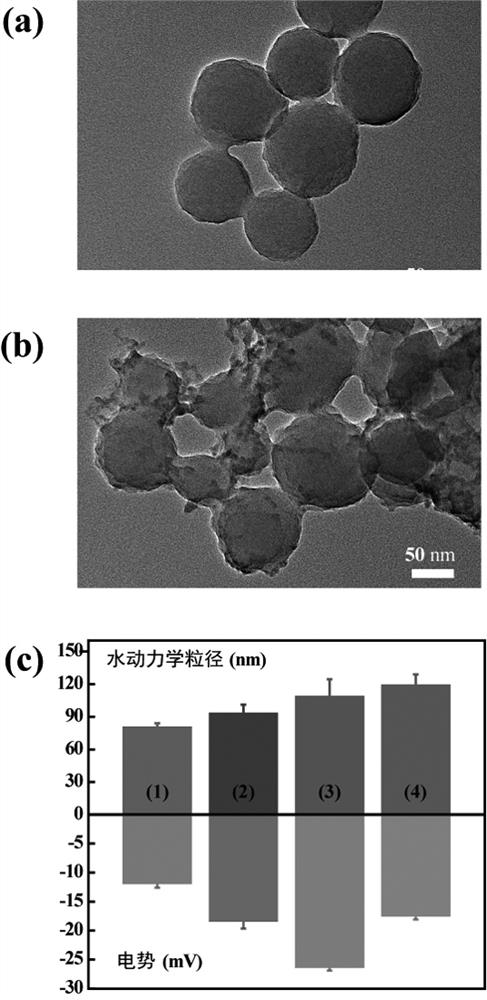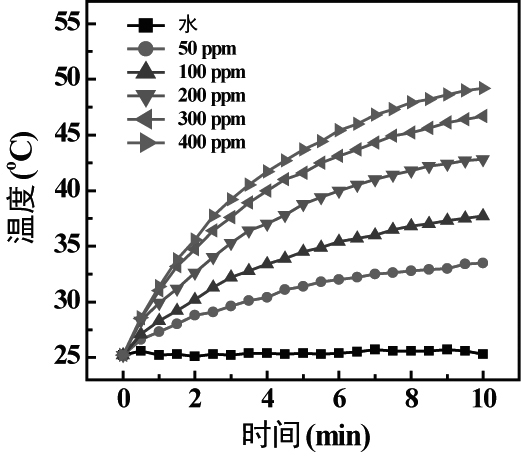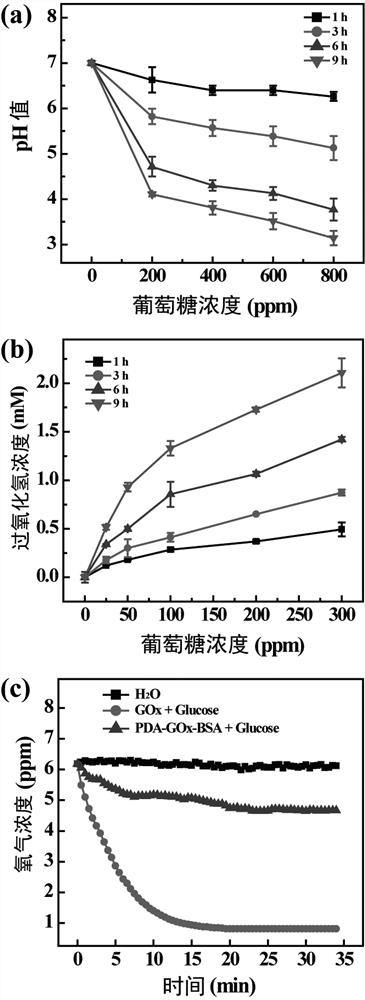The construction and application of catalytic nanoparticles based on glucose oxidase/iron phosphate
A glucose oxidase and nanoparticle technology, applied in the field of nanodiagnostic agent preparation, can solve the problems of insufficient Fenton reaction to maintain high efficiency, Fenton reaction obstruction, etc., and achieve enhanced chemodynamic therapy, significant inhibitory effect, and mild preparation process. Effect
- Summary
- Abstract
- Description
- Claims
- Application Information
AI Technical Summary
Problems solved by technology
Method used
Image
Examples
Embodiment 1
[0044] Take 2.6 mL of ammonia water, 90 mL of ethanol, and 40 mL of distilled water, respectively, and magnetically stir them in a water bath at 45 °C to fully mix them. After 15 minutes, 10 mL of a 50 mg / mL dopamine monomer aqueous solution was added. After 12 h of reaction, centrifuge purification (16000 rpm, 10 min) to collect polydopamine nanoparticles (PDA).
[0045] According to the mass ratio of 1:1, the prepared polydopamine nanoparticles and glucose oxidase were mixed in 10 mM Tris buffer with pH 8.5, stirred in a water bath at 37 °C for 24 hours, and purified by centrifugation to obtain the loaded glucose oxidized. Enzymatic polydopamine nanoparticles (PDA-GOx).
[0046] The aqueous solutions of PDA-GOx and bovine serum albumin BSA were mixed in a mass ratio of 1:2, and the reaction solution was a phosphate buffer at pH 7.4. After 24 hours of magnetic stirring at room temperature, the BSA-encapsulated PDA-GOx nanoparticles (PDA-GOx-BSA) were obtained by centrifugat...
Embodiment 2
[0050] The PDA-GOx-BSA-FePi nanoparticles prepared in Example 1 were taken and prepared into aqueous solutions of 50, 100, 200, 300, and 400 ppm, and placed in a quartz dish for laser irradiation. The laser wavelength used is 808 nm and the power per unit area is 1.0W / cm 2 . Temperatures were recorded every 0.5 min during the laser process for a total of 10 min.
[0051] Heat production test results ( figure 2 ) showed that the temperature of the solution gradually increased with the laser irradiation. The magnitude of the temperature rise is positively correlated with the nanoparticle concentration. This indicates that the obtained composite nanoparticles have good photothermal effect.
Embodiment 3
[0053] The PDA-GOx-BSA-FePi nanoparticles prepared in Example 1 were mixed with glucose, and the pH value was monitored in real time by a pH meter. 1.44 mg of PDA-GOx-BSA-FePi nanoparticles were mixed with 10 mL of glucose at different concentrations (200, 400, 600, 800 ppm) and stirred in a 37 °C water bath, which was continuously fed with oxygen. Changes in pH were recorded at different time points (1, 3, 6, 9 h).
[0054] Take the PDA-GOx-BSA nanoparticles prepared in Example 1, and use ammonium titanium oxalate as an indicator to measure H 2 O 2 concentration. 1.00 mg of PDA-GOx-BSA was mixed with 2 mL of glucose at various concentrations (25, 50, 100, 200, 300 ppm). At certain time points (1, 3, 6, 9 h), the mixture was centrifuged to collect the supernatant. Then 0.8 mL of the supernatant was mixed with 0.2 mL of 0.01 M ammonium oxalate solution, and the absorbance at 405 nm was analyzed with a UV-Vis spectrophotometer to calculate H 2 O 2 concentration.
[0055] ...
PUM
| Property | Measurement | Unit |
|---|---|---|
| size | aaaaa | aaaaa |
| wavelength | aaaaa | aaaaa |
Abstract
Description
Claims
Application Information
 Login to View More
Login to View More - R&D
- Intellectual Property
- Life Sciences
- Materials
- Tech Scout
- Unparalleled Data Quality
- Higher Quality Content
- 60% Fewer Hallucinations
Browse by: Latest US Patents, China's latest patents, Technical Efficacy Thesaurus, Application Domain, Technology Topic, Popular Technical Reports.
© 2025 PatSnap. All rights reserved.Legal|Privacy policy|Modern Slavery Act Transparency Statement|Sitemap|About US| Contact US: help@patsnap.com



